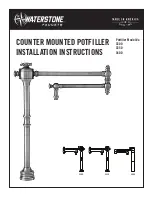
41
Wavin AS+
Technical Manual
Rainwater pipes
Rainwater pipes must be capable of withstanding higher
pressures under certain circumstances. Pressures above
those foreseen may arise, for example, when overloaded
sewers cause build-ups of rainwater. Thrust resistance must be
sufficient to guarantee operating safety and reliability in such
cases. To ensure this, the sleeves must be fastened using
Wavin LKS clamps, for example.
The installation of rainwater pipes is also affected by the issue
of condensation. Under certain operating conditions relating
to room temperature, relative humidity in the room concerned
and the temperature of the rainwater, the dew point of internal
rainwater pipes may drop to below that specified.
Diffusion-resistant insulation should normally be fitted to inter-
nal rainwater pipes subject to any latent risk of condensation.
Rainwater downpipes/calculation
The minimum dimensions must not be less than the connec-
tion diameter of the roof guttering.
Dimensions are calculated subject to rules similar to those
governing the layout of collecting pipes described on page 33
of this waste water manual.
The filling factor of r rainwater downpipes totals f ≤ 0.33
Downpipe deviations ≤ 10° are not taken into account when
calculating the dimensions of the rainwater downpipe. If
downpipe offsets are ≥ 10°, the sizing should be calculated
subject to rules similar to those governing the layout of col-
lecting pipes described in Chapter 4 of this waste water
manual.
Fig.: 26: Drainage performance of rainwater downpipes.
Fig. 27: Nominal width and internal diameter, AS+.
Nominal diameter
Internal diameter
DN
Di (mm)
50
44
70
68
90
80.8
100
99.4
125
114.4
150
148.8
200
188
Inner diameter down pipe
Rainwater
flow
rate
Q
70
l/s
60
50
75
100
125
150
175 mm
f = 0,33
200
50
40
30
20
10
0
















































